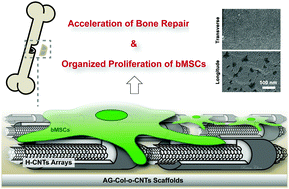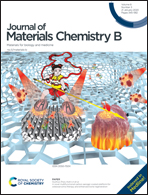Biomimetic bone tissue engineering hydrogel scaffolds constructed using ordered CNTs and HA induce the proliferation and differentiation of BMSCs
Abstract
The use of bone tissue engineering scaffolds has become a promising potential treatment for bone defects as they expedite bone healing. A carbon nanotube–hydroxyapatite (CNT–HA) composite can accelerate the growth of cells. However, the molecular organized arrangement of organic and inorganic components is one of the most important biochemical phenomena in the formation of bones. This study aimed to prepare ordered CNT–HA scaffolds by applying agarose gel electrophoresis to imitate a biomimetic parallel pattern of collagens and hydroxyapatite hydrogel scaffolds (AG-Col-o-CNT). Significant improvements were presented in the mechanical properties of the scaffolds and cell growth in vitro or in vivo. The results showed that the AG-Col-o-CNT scaffolds accelerated the proliferation and differentiation of bone mesenchymal stem cell lines. In addition, the bone defects were repaired when the scaffolds were transplanted after 28 and 56 days in vivo. The superior performance of the ordered AG-Col-o-CNT scaffolds indicates that they have an enormous potential for bone tissue engineering.



 Please wait while we load your content...
Please wait while we load your content...